Effects of Isothermal Temperature on Dislocation Density in Bainite Transformation of 4140 Steel
Abstract
1. Introduction
2. Materials and Methods
2.1. Material
2.2. Heat Treatment Experiment Procedures
3. Results and Analysis
3.1. Microstructures Observed
3.2. X-ray Diffraction and Line Broadening Analysis
3.3. Average Dislocation Density
3.4. Isothermal Temperature Effect on Dislocation Density & Hardness
3.5. Bainite Phase Matrix Dislocation Density
3.6. Isothermal Temperature Effect on Crystallite Size D and Microstrain
3.7. Dislocation Density and Bainite Activation Energy
3.8. Average Dislocation Density vs. Cooling Rate
4. Discussion
- As isothermal temperature rises from 288 °C to 454 °C, the average dislocation density in the 4140 steel with bainitic microstructure decreases from 1.55 × 1017 (m−2) to 8.33 × 1015 (m−2). This is due to the reduction in the plastic deformation in the austenite during the transformation. As the dislocation density decreases, the hardness decreases from 50HRC to 30HRC. The dislocation density at the magnitude of +17 (m−2) level seems high, most likely caused by tetragonality, which can expand the line broadening.
- As isothermal temperatures rise from 288 °C to 454 °C, four groups of bainite phase matrices will form, which are lower bainite and martensite mixture, lower bainite, lower bainite and upper bainite mixture, and upper bainite. The average dislocation density related to the four groups are 1.29 × 1017 (m−2), 9.62 × 1016 (m−2), 7.48 × 1016 (m−2), and 1.7 × 1016 (m−2), respectively.
- The bainite transformation activation energies of all four microstructure groups were calculated and related to the dislocation density. As the activation energy decreases, the average dislocation density decreases only to the lower bainite phase. The trend reverses to higher free energy required with the lower bainite and martensite mixed phase due to the kinetic acceleration requirement of pre-existing martensite.
- As the isothermal temperature rises, the microstructure crystallite size increases and the non-uniform micro strain decreases; in turn, the dislocation density decreases.
- As isothermal temperatures decrease below the undercooling temperature of 454 °C and as the cooling rate increases from 400 °C/s to 566 °C/s, the thermal dynamic driving force of the bainite transformation increases. The average dislocation density in the bainitic phase matrix increases from 8.33 × 1015 (m−2) to 1.55 × 1017 (m−2).
- The present work determined the average dislocation density. Due to the inhomogeneous dislocation distribution in the bainite phase matrix, the effect of differences between edge dislocations and screw dislocations was not considered.
- The results of estimated average dislocation density obtained by this research are slightly higher than those of some published works, possibly due to the tetragonality of BCT unit cells. A remedy is proposed in the conclusions section.
5. Conclusions
Author Contributions
Funding
Institutional Review Board Statement
Informed Consent Statement
Data Availability Statement
Conflicts of Interest
References
- Bhadeshia, H.K.D.H. Bainite in Steel; Institute of Materials: London, UK, 2001. [Google Scholar]
- Caballero, F.G.; Garcia-Mateo, C.; Santofimia, M.J.; Miller, M.K.; de Andres, C.G. New experimental evidence on the incomplete transformation phenomenon in steel. Acta Mater. 2009, 57, 8–17. [Google Scholar] [CrossRef]
- Bhadeshia, H.K.D.H. Atomic mechanism of bainite transformation. HTM J. Heat Treat. Mater. 2017, 72, 340–345. [Google Scholar] [CrossRef]
- He, S.; He, B.; Zhu, K.; Huang, M. Evolution of dislocation density in bainitic steel: Modeling and experiments. Acta Mater. 2018, 149, 46–56. [Google Scholar] [CrossRef]
- Nurbanasari, M.; Tsakiropoulos, J.; Palmiere, E. Influence of high temperature deformation and double tempering on the microstructure of a h21 tool steel. Mater. Sci. Eng. A 2013, 570, 92–101. [Google Scholar] [CrossRef]
- Haji-akbari, F.; Nili-Ahmadabadi, M.; Pishbin, H.; Poorganji, B.; Furuhara, T. Microstrual study of the multiphase bainitic steel through heavy compression. Int. J. Mod. Phys. Conf. Ser. 2012, 5, 350–358. [Google Scholar] [CrossRef]
- Garcia-Mateo, C.; Paul, G.; Somani, M.C.; Porter, D.A.; Bracke, L.; Latz, A.; de Andres, C.G.; Caballero, F.G. Transferring nanoscale bainite concept to lower C contents: A perspective. Metals 2017, 5, 159. [Google Scholar] [CrossRef]
- Ogawa, K.; Sawaguchi, T.; Kajiwara, S. Atomic arrangement of interphase boundary between bainite and austenite in Fe-C alloy. Mater. Trans. 2010, 51, 455–462. [Google Scholar] [CrossRef]
- Bhadeshia, H.K.D.H.; Christian, J.W. Bainite in Steel. Metall. Trans. A 1990, 21, 767–797. [Google Scholar] [CrossRef]
- Bhadeshia, H.K.D.H. Martensite and Bainite: Transformation mechanism & mechanical properties. J. Phys. IV Fr. 1997, 7, C5-367–C5-376. [Google Scholar]
- Chen, C.Y.; Chen, C.C.; Lin, J.S. Morphology feature of nanostructure bainitic steel after tempering treatment. Int. J. Chem. Biol. Eng. 2014, 8, 928–932. [Google Scholar]
- Guo, Y.; Feng, K.; Lu, F.; Zhang, K.; Li, Z.; Hossein, S.R.E.; Wang, M. Effects of isothermal heat treatment on nanostructured bainite morphology and microstructures in laser cladded coatings. Appl. Surf. Sci. 2015, 357, 309–316. [Google Scholar] [CrossRef]
- Guo, Y.; Yao, C.; Feng, K.; Li, Z.; Hu, K.; Wu, Y. Effect of Isothermal temperature on growth behavior of nanostructured bainite in laser cladded coatings. Materials 2017, 10, 800. [Google Scholar] [CrossRef] [PubMed]
- Caballero, F.G.; Miller, M.K.; Clarke, A.J.; Garcia-Mateo, C. Examination of carbon partitioning into austenite during tempering of bainite. Scr. Mater. 2010, 63, 442–445. [Google Scholar] [CrossRef]
- Timokhina, I.B.; Liss, K.D.; Raabe, D.; Rakha, K.; Beladi, H.; Xiong, X.Y.; Hodgson, P.D. Growth of bainite ferrite and carbon partitioning during the early stages of bainitic transformation in a 2 mass% silicon steel studies in situ neutron diffraction. TEM APT. J. Appl. Crystallogr. 2016, 49, 399–414. [Google Scholar] [CrossRef]
- Caballero, F.G.; Miller, M.K.; Babu, S.S.; Garcia-Mateo, C. Atomic scale observations of bainite transformation in a high carbon high silicon steel. Acta Mater. 2017, 5, 381–390. [Google Scholar] [CrossRef]
- Caballero, F.G.; Miller, M.K.; Garcia-Mateo, C. Carbon super structuration on ferrite in a nanocrystalline bainite steel. Acta Mater. 2010, 58, 2338–2343. [Google Scholar] [CrossRef]
- Catteau, S.D.; van Landeghem, H.P.; Teixeria, J.; Dehmas, J.D.J.; Moukrane, D.; Sabine, R.; Abdelkrim, C.; Courteaux, M. Carbon and nitrogen effects on microstructure and kinetics associated with bainite transformation in a low-alloyed steel. J. Alloy. Compd. 2016, 658, 832–838. [Google Scholar] [CrossRef]
- Garcia-Mateo, C.; Caballero, F.G.; Bhadeshia, H.K.D.H. Mechanical properties of low-temperature bainite. Mater. Sci. Fourm 2005, 500–501, 495–502. [Google Scholar] [CrossRef]
- Nakai, K.; Sakamoto, T.; Asakura, R.; Kotani, Y.; Isomura, N.; Kobayashi, S.; Hamada, M.; Komizo, Y. Nucleation of bainite at Small Angle Dislocation network in austenite and its effects on mechanical properties in steels. ISIJ Int. 2011, 51, 274–279. [Google Scholar] [CrossRef][Green Version]
- Avishan, B. Effect of dislocation density on deformation behavior of super strong bainitic steel. J. Adv. Mater. 2017, 35, 101–111. [Google Scholar] [CrossRef][Green Version]
- Garcia-Mateo, C.; Caballero, F.G. Ultra-high-strength bainitic steel. ISIJ Int. 2005, 45, 1736–1740. [Google Scholar] [CrossRef]
- Zhu, M.; Xu, G.; Zhou, M.; Yuan, Q.; Tian, J.; Hu, H. Effects of tempering on the microstructure and properties of a high-strength bainitic rail steel with good toughness. Metals 2018, 8, 484. [Google Scholar] [CrossRef]
- Sekido, K.; Ohmura, T.; Hara, T.; Tsuzaki, K. Effect of dislocation density on the initiation of plastic deformation on Fe-C steels. Mater. Trans. 2012, 53, 907–912. [Google Scholar] [CrossRef]
- Ostash, V.V.; Kulyk, V.D.; Poznyakov, O.A.; Haivorons’kyi, L.I.; Markashova, V.V.; Vira, Z.A.; Duriagina, T.L. Tepla: Fatigue crack growth resistance of welded joints simulating the weld-repaired railway wheels metal O. P. Arch. Mater. Sci. Eng. 2017, 2, 49–52. [Google Scholar]
- Williamson, G.K.; Smallman, R.E. Dislocation density in some annealed and cold-worked metals from measurements on the x-ray Debye-Scherrer spectrum. Philos. Mag. 1956, 1, 34–46. [Google Scholar] [CrossRef]
- Garcia-Mateo, C.; Caballero, F.G.; Capdevila, C.; de Andres, C.G. Estimation of dislocation density in bainitic microstructures using high-resolution dilatometry. Scr. Mater. 2009, 61, 855–858. [Google Scholar] [CrossRef]
- Martin, D.S.; Garcia-Mateo, C.; Caballero, F.G.; Capdevila, C.; de Andres, C.G. A model to Estimate Microstructural Parameters from High Resolution Dilatometry Data; ICAS: Guilin, China, 2010; ISBN 987-7-5024-5423-4. [Google Scholar]
- Williams, D.B.; Carter, C.B. Transmission Electron Microscopy: A Textbook of Material Science; Plenum Press: New York, NY, USA, 1996. [Google Scholar]
- Cornide, J.; Miyamoto, G.; Caballero, F.G.; Furuhara, T.; Miller, M.K.; Garcia-Mateo, C. Distribution of dislocations in nanostructured bainite. Solid State Phenom. 2011, 172–174, 117–123. [Google Scholar] [CrossRef]
- Caballero, F.G.; Yen, H.; Miller, M.K.; Yang, J.; Cornide, J.; Garcia-Mateo, C. Complementary use of transmission electron microscopy and atom probe tomography for the examination of plastic accommodation in nanocrystalline bainitic steels. Acta Mater. 2011, 59, 6117–6123. [Google Scholar] [CrossRef]
- Keijser, T.H.D.; Langford, J.I.; Mittemeijier, E.J.; Vogels, B.P. Use of the Voigt function in a single-line method for the analysis of X-ray diffraction line broadening. J. Appl. Cryst. 1982, 15, 308–314. [Google Scholar] [CrossRef]
- Williamson, G.K.; Hall, W.H. X-ray line broadening from field aluminum and wolfram. Acta Metall. 1953, 1, 22–31. [Google Scholar] [CrossRef]
- Longford, J.I. X-ray Powder Diffraction Studies of Vitromet Samples. J. Appl. Cryst. 1971, 4, 164–168. [Google Scholar] [CrossRef]
- Sun, X.X.; Northwood, D.O. Effect of substructure on the thermoelectric power of deformed Zr-Cr-Fe sheet. Mater. Charact. 1993, 30, 97–105. [Google Scholar] [CrossRef]
- Xiong, F. X-ray Metallurgy; Mechanical Industry Press: Beijing, China, 1981. (In Chinese) [Google Scholar]
- Takaki, S.; Masumura, T.; Jiang, F.; Tsuchiyama, T. Effect of instrumental correction on X-ray line profile analysis in cold rolled ferritic steel. ISIJ Int. 2018, 58, 1181–1183. [Google Scholar] [CrossRef]
- Bhadeshia, H.K.D.H. Anomalies in carbon concentration determinations from nanostructured bainite. Mater. Sci. Technol. 2015, 31, 758–763. [Google Scholar] [CrossRef]
- Zhu, J.; Sun, X.; Baber, G.; Han, X.; Qin, H. Bainite transformation kinetics of a Cr-Mo medium carbon alloyed steel. In Proceedings of the MST18, Columbus, OH, USA, 14–18 October 2018; pp. 1081–1088. [Google Scholar]
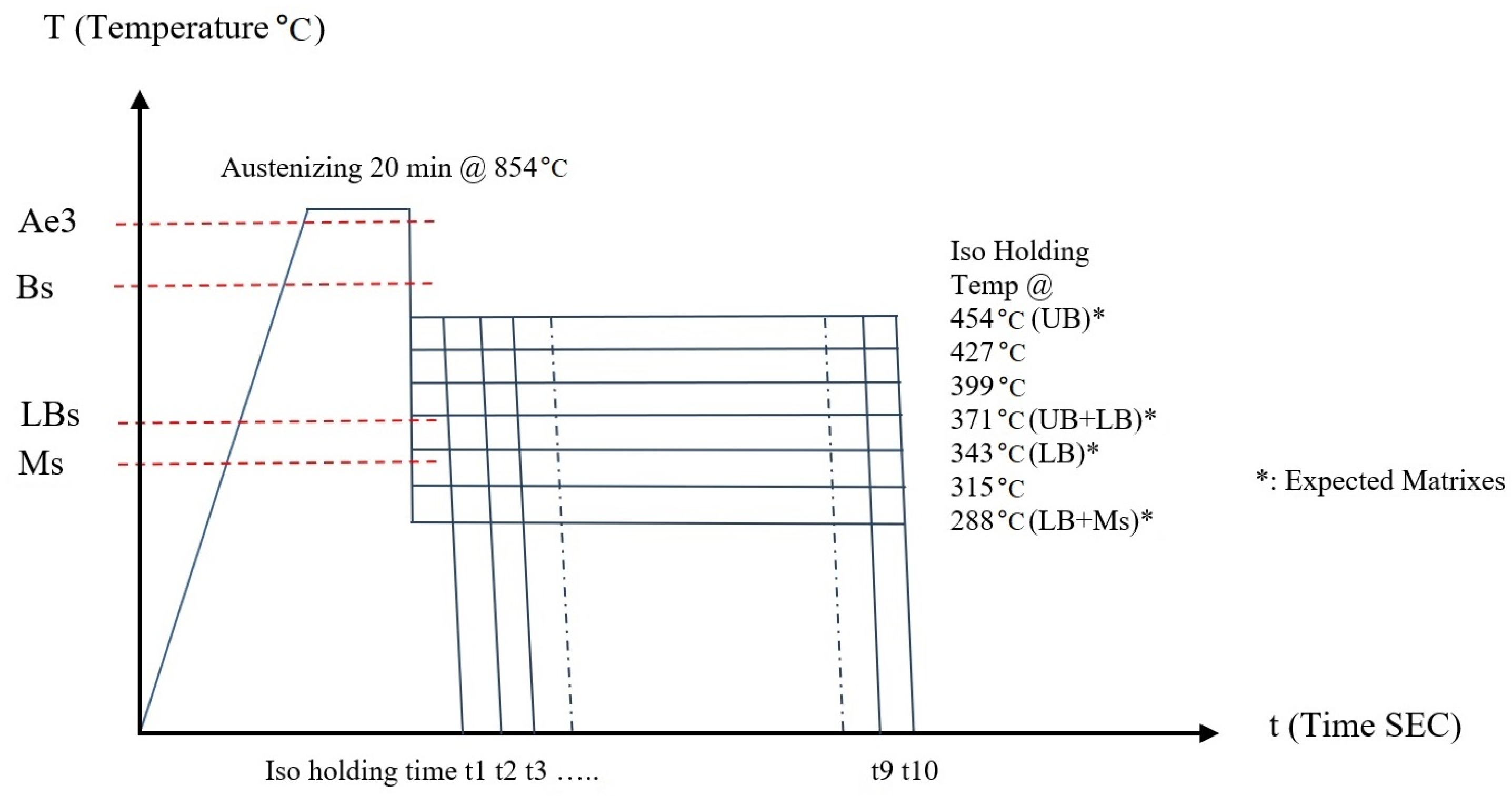
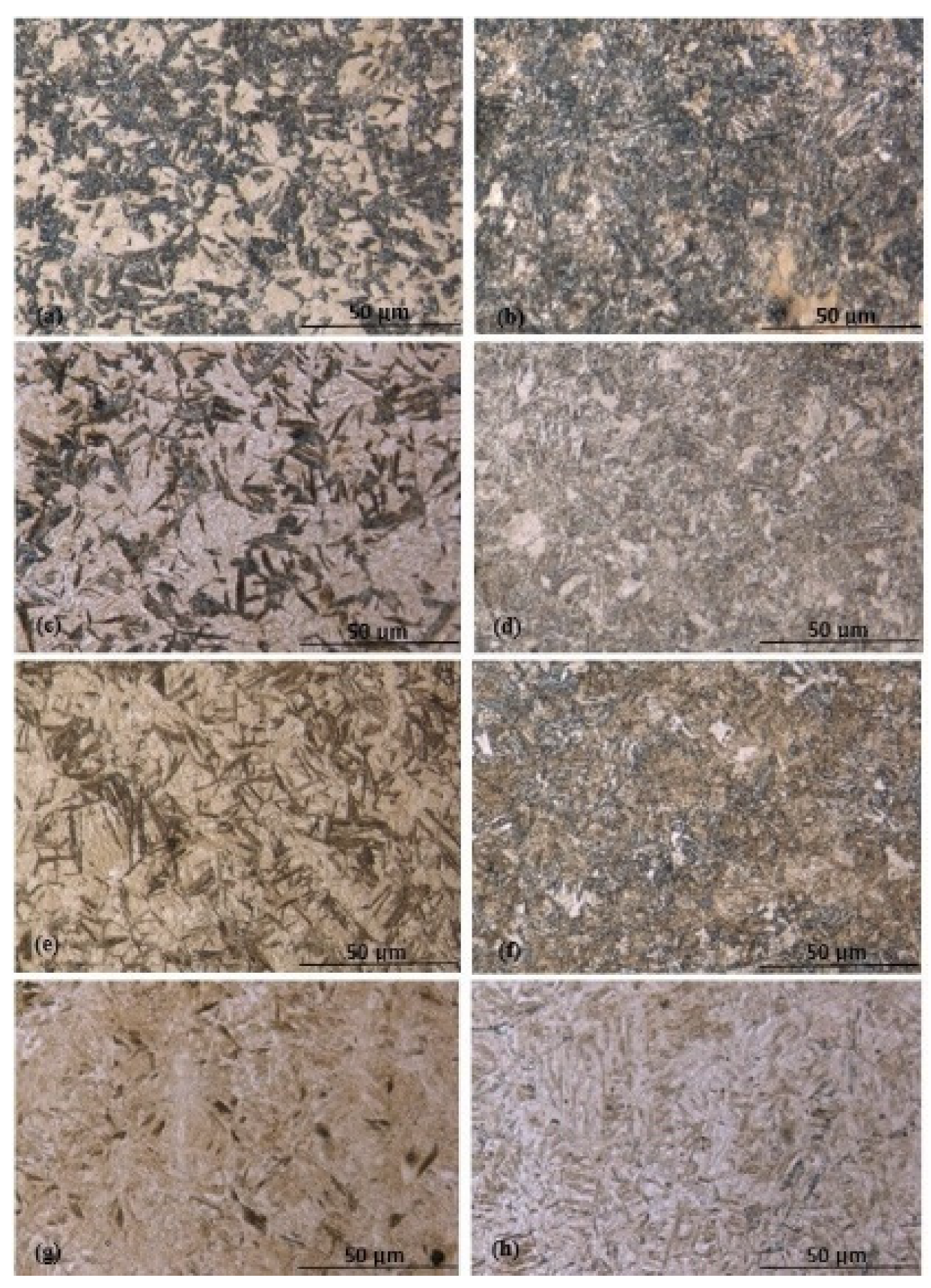
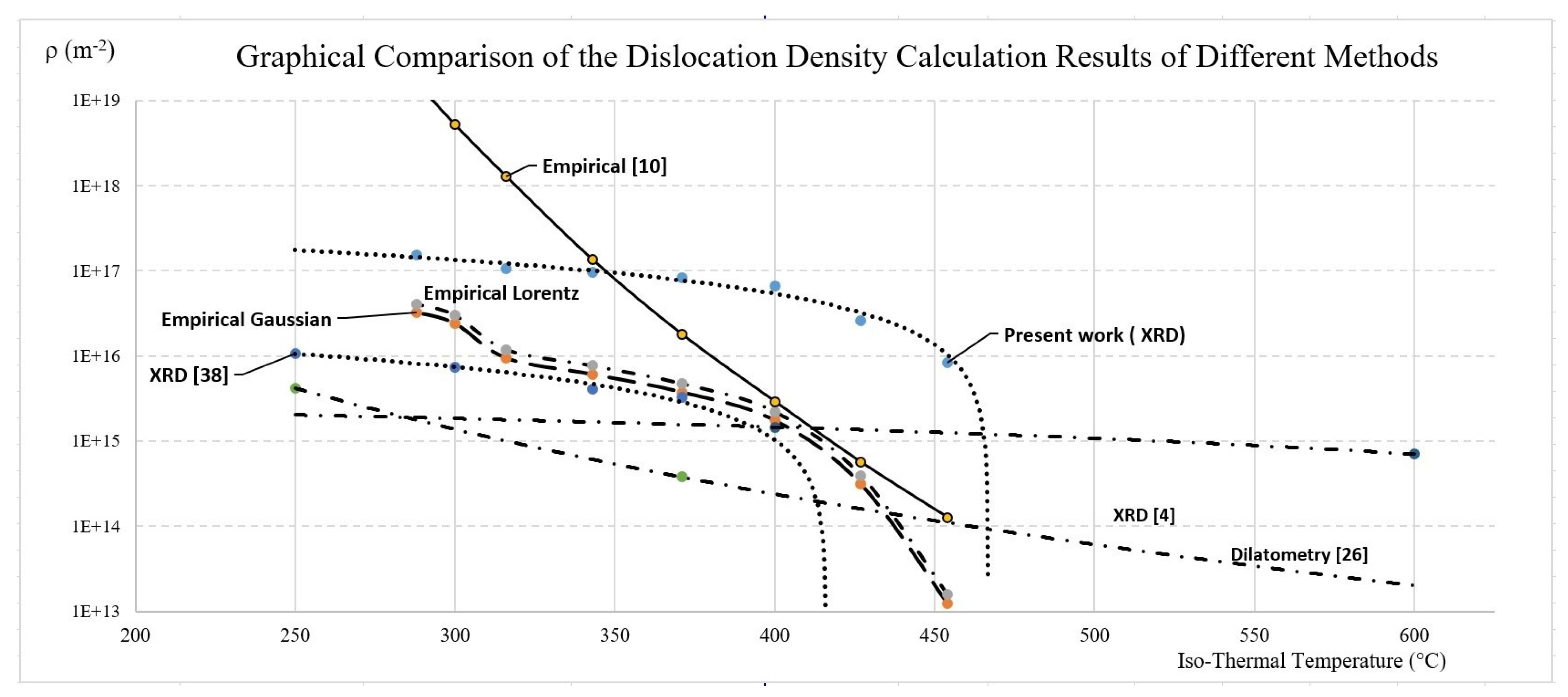

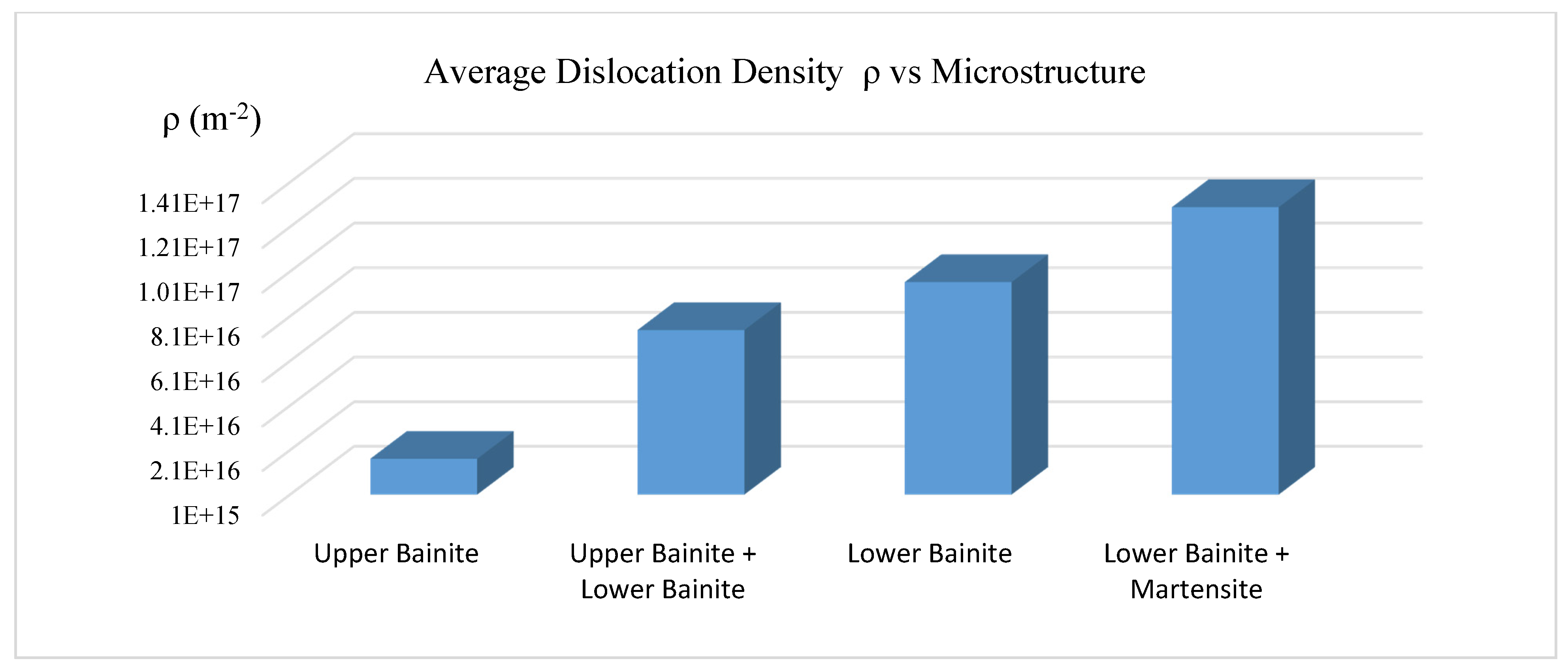
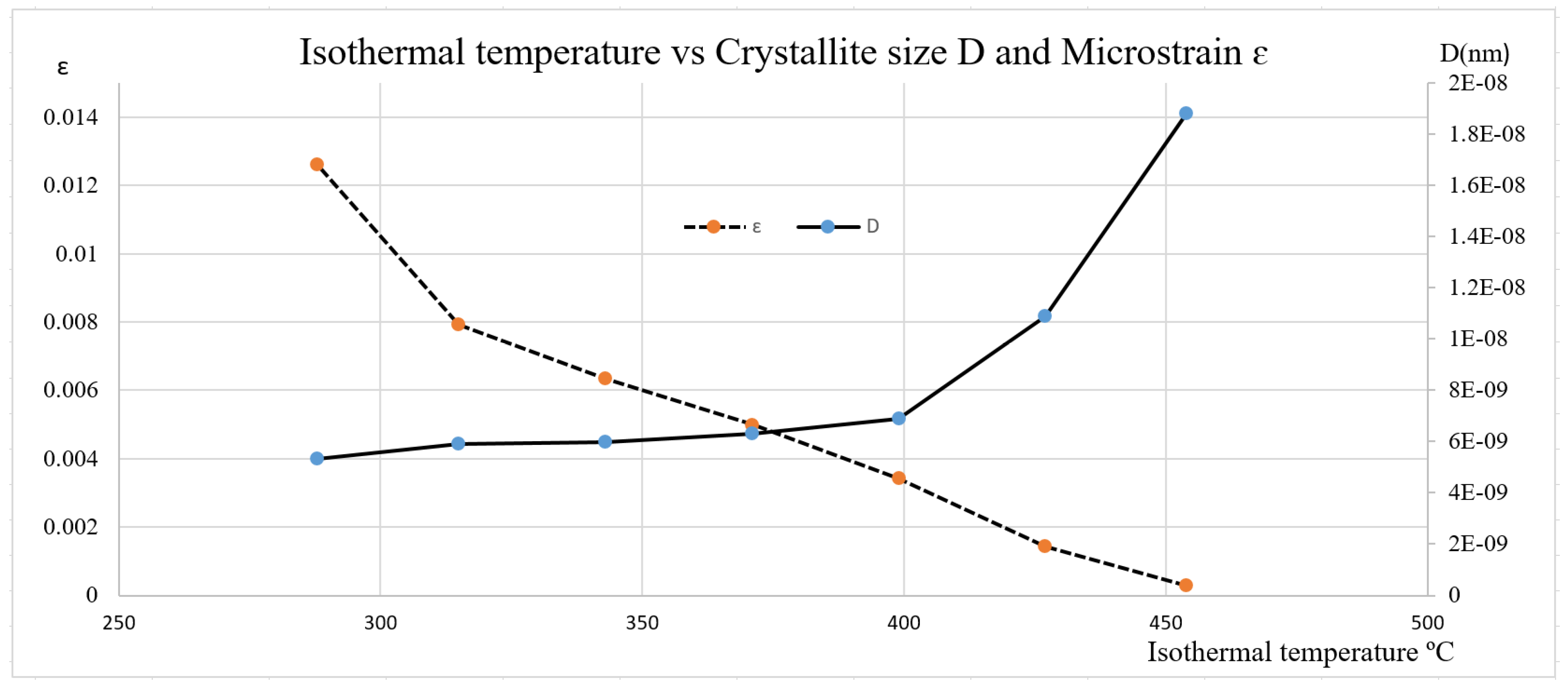
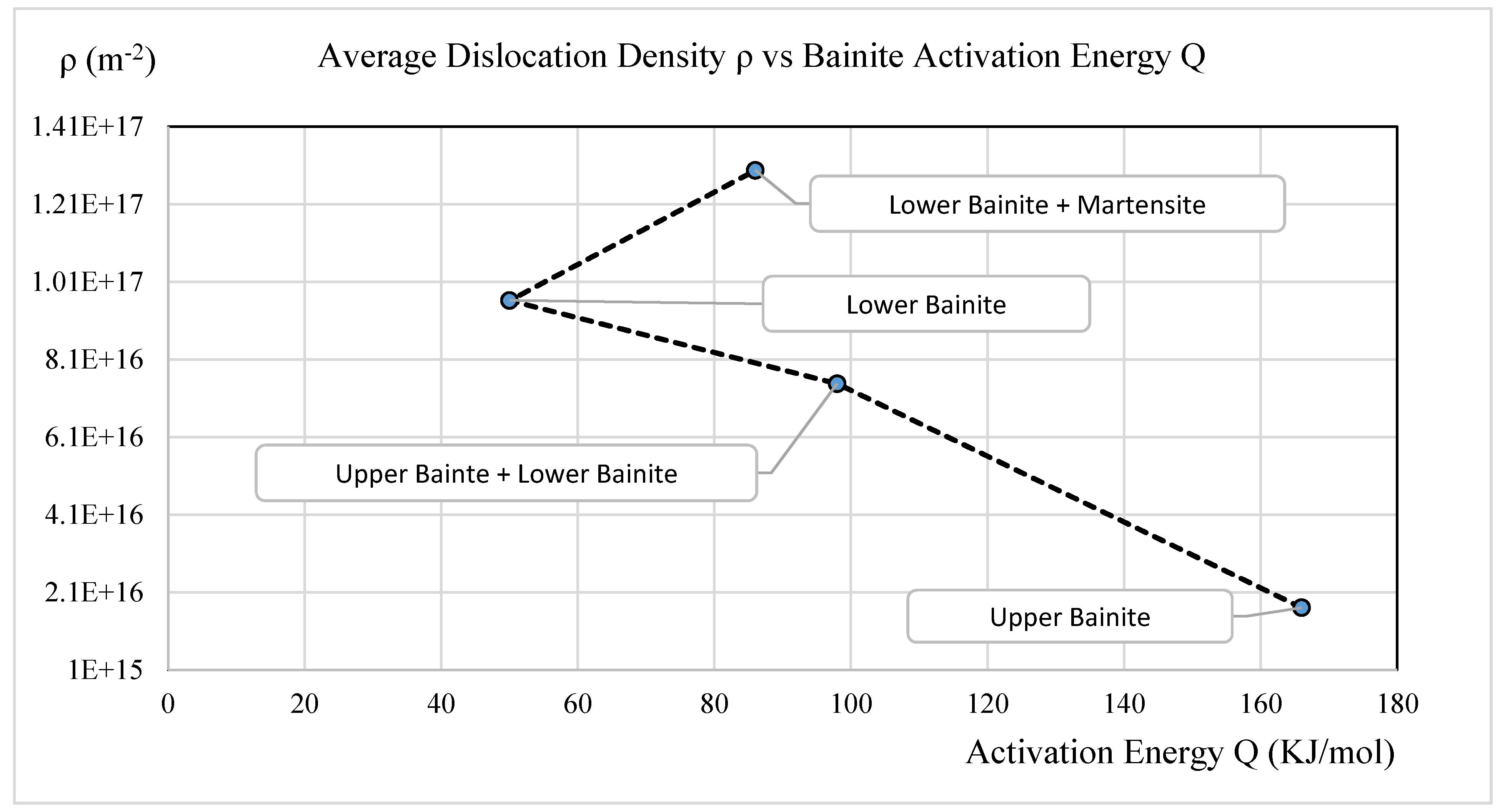

| Iso-Temp (°C) | (mm) | (mm) | (mm) | (mm) | (mm) | (mm) | D (nm) | ε |
|---|---|---|---|---|---|---|---|---|
| 454 | 10.7 | 17.4 | 10.5 | 16.9 | 2.0591 | 4.1412 | 1.88 × 10−8 | 0.00028 |
| 427 | 11.2 | 18.9 | 10.5 | 16.9 | 3.8974 | 8.4616 | 1.09 × 10−8 | 0.00143 |
| 399 | 12.4 | 22.6 | 10.5 | 16.9 | 6.5962 | 15.0049 | 6.89 × 10−9 | 0.00341 |
| 371 | 13 | 24.8 | 10.5 | 16.9 | 7.6648 | 18.1502 | 6.31 × 10−9 | 0.00499 |
| 343 | 13.5 | 26.7 | 10.5 | 16.9 | 8.4852 | 20.6707 | 5.98 × 10−9 | 0.00635 |
| 316 | 13.9 | 28.5 | 10.5 | 16.9 | 9.1082 | 22.9486 | 5.92 × 10−9 | 0.00791 |
| 288 | 15.6 | 35.2 | 10.5 | 16.9 | 11.5373 | 30.8776 | 5.31 × 10−9 | 0.01261 |
| Isothermal Temp (°C) | Present Work (XRD) | Empirical Gaussian [37] | Empirical Lorentz [37] | Empirical Takahashi [1] | XRD [22] | Dilatometry [27] | XRD [4] |
|---|---|---|---|---|---|---|---|
| 454 | 8.44 × 1015 | 1.24 × 1013 | 1.57 × 1013 | 1.27 × 1014 | 7.0 × 1014–1.46 × 1015 400–600 °C | ||
| 427 | 2.57 × 1016 | 3.10 × 1014 | 3.93 × 1014 | 5.64 × 1014 | |||
| 400 | 6.67 × 1016 | 1.75 × 1015 | 2.21 × 1015 | 2.92 × 1015 | |||
| 371 | 8.29 × 1016 | 3.74 × 1015 | 4.73 × 1015 | 1.79 × 1016 | 3.29 × 1015 | 3.77 × 1014 | |
| 343 | 9.62 × 1016 | 6.06 × 1015 | 7.67 × 1015 | 1.35 × 1017 | 4.11 × 1015 | ||
| 316 | 1.05 × 1017 | 9.39 × 1015 | 1.18 × 1016 | 1.28 × 1018 | |||
| 300 | 2.38 × 1016 | 3.02 × 1016 | 5.18 × 108 | 7.43 × 1015 | |||
| 288 | 1.55 × 1017 | 3.21 × 1016 | 4.07 × 1016 | 1.62 × 1019 | |||
| 250 | 1.07 × 1016 | 4.2 × 1015 |
Publisher’s Note: MDPI stays neutral with regard to jurisdictional claims in published maps and institutional affiliations. |
© 2022 by the authors. Licensee MDPI, Basel, Switzerland. This article is an open access article distributed under the terms and conditions of the Creative Commons Attribution (CC BY) license (https://creativecommons.org/licenses/by/4.0/).
Share and Cite
Zhu, J.; Barber, G.; Sun, X. Effects of Isothermal Temperature on Dislocation Density in Bainite Transformation of 4140 Steel. Materials 2022, 15, 6066. https://doi.org/10.3390/ma15176066
Zhu J, Barber G, Sun X. Effects of Isothermal Temperature on Dislocation Density in Bainite Transformation of 4140 Steel. Materials. 2022; 15(17):6066. https://doi.org/10.3390/ma15176066
Chicago/Turabian StyleZhu, Jian, Gary Barber, and Xichen Sun. 2022. "Effects of Isothermal Temperature on Dislocation Density in Bainite Transformation of 4140 Steel" Materials 15, no. 17: 6066. https://doi.org/10.3390/ma15176066
APA StyleZhu, J., Barber, G., & Sun, X. (2022). Effects of Isothermal Temperature on Dislocation Density in Bainite Transformation of 4140 Steel. Materials, 15(17), 6066. https://doi.org/10.3390/ma15176066






